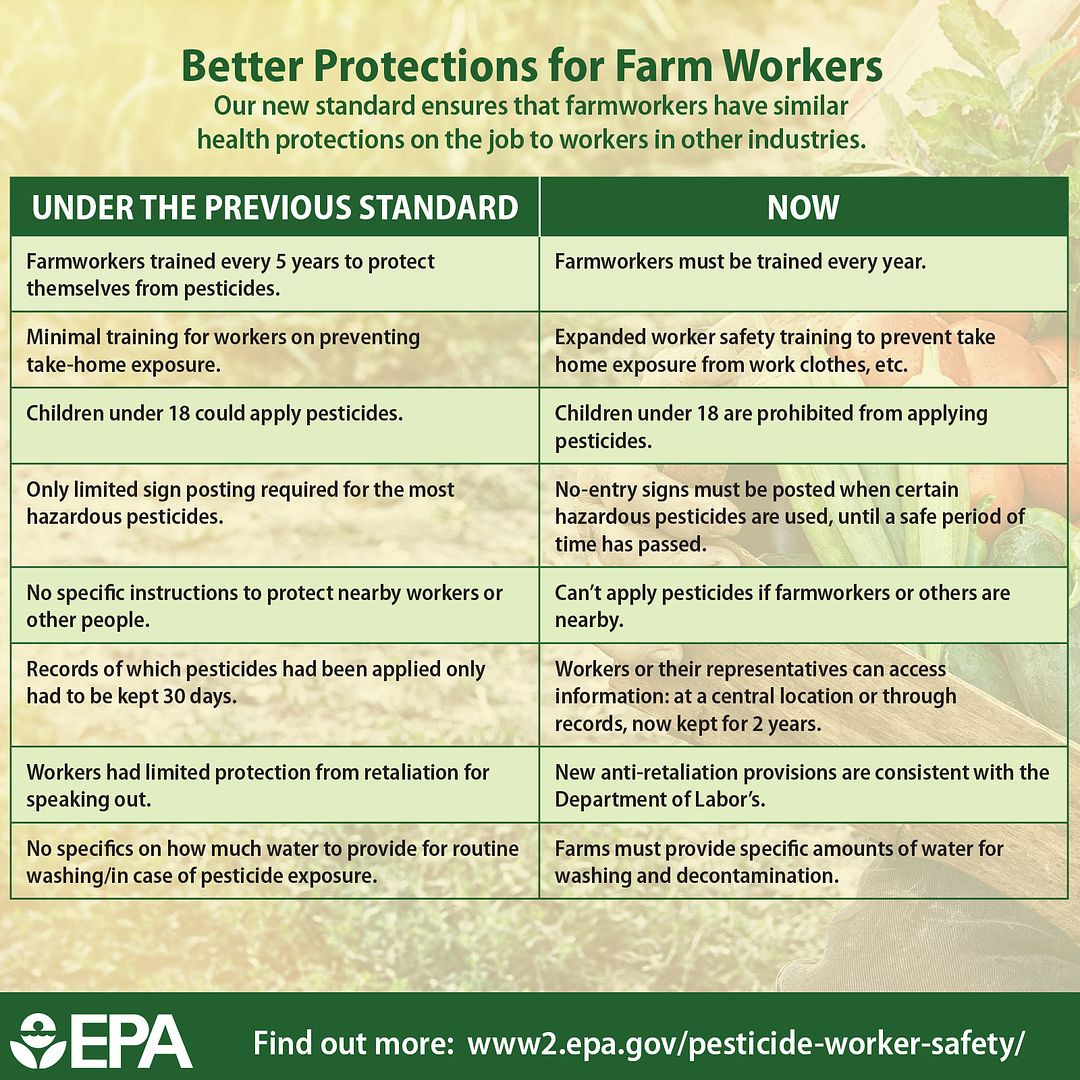On Monday the U.S. Environmental Protection Agency released the final version of “stronger protections for the nation’s two million agricultural workers and their families working on farms, forests, nurseries, and greenhouses. These revisions to the 1992 Agricultural Worker Protection Standard will afford farmworkers similar health protections that are already afforded to workers in other industries.” Under the old rules, exposure to chemicals incurred “an estimated $10 million to $15 million in annual health costs” among farm workers The new rules do not cover “persons working with livestock” and exempt “farm owners and their immediate family with an expanded definition of family.” I’ve enclosed after the jump a fact sheet summarizing key changes, a short summary of the public health case for the rule, and a graphic that shows the old and new rules side by side. Click here for the EPA’s press release on the changes and here for a more detailed five-page chart.
Fruit and vegetable farming isn’t a huge industry in Iowa like it is in states with longer growing seasons, such as California or Florida. Still, Iowa farms have been producing more of what some call “specialty crops” as more consumers here seek out local food. Moreover, expanding fruit and vegetable production in Iowa has potential to create jobs and increase local incomes, according to this 2010 paper by Iowa State University economist Dave Swenson. So I sought comment from the Iowans in Congress on the new regulations. At this writing, I have not heard back from the offices of House Representatives Rod Blum (IA-01), Dave Loebsack (IA-02), David Young (IA-03), or Steve King (IA-04). I also haven’t received a comment from Senator Chuck Grassley. Senator Joni Ernst’s communications director sent the following:
Senator Ernst believes that once again the Obama Administration is overstepping its bounds, expanding onerous regulations that fail to consider the full impact on stakeholders, like Iowa’s agriculture industry. The EPA is continuing to act as an unchecked federal agency, adding burdensome new rules and costs. In addition, the EPA completely ignores the safety progress that has already been made under existing guidelines for our youth.
Iowa politicians tend to be hostile to any new regulation affecting farms or other agricultural facilities. Most of Iowa’s federal representatives opposed the U.S. Department of Labor’s efforts in 2011 to update protections for children on working farms. Every Iowan in Congress except for Senator Tom Harkin welcomed the department’s decision to withdraw that rule in April 2012.
A spokesperson for Governor Terry Branstad said they don’t have a reaction to the new farm worker safety rule yet but will evaluate it “in its entirety.” I can’t think of a time Branstad supported any regulation of farming practices, so I assume he will not be favorably disposed toward the new EPA rule. But if he’s serious about making Iowa the “healthiest state,” reducing unnecessary exposure to pesticides would be a worthy goal to embrace.
From an EPA fact sheet released on September 28:
Changes to EPA’s Farm Worker Protection Standard
The Environmental Protection Agency has revised the 1992 Agricultural Worker Protection Standard regulation to increase protection from pesticide exposure for the nation’s two million agricultural workers and their families. These changes will afford farmworkers similar health protections that are already afforded to workers in other industries while taking into account the unique working environment of many agricultural jobs.
The regulation seeks to protect and reduce the risks of injury or illness resulting from agricultural workers’ (those who perform hand-labor tasks in pesticide-treated crops, such as harvesting, thinning, pruning) and pesticide handlers’ (those who mix, load and apply pesticides) use and contact with pesticides on farms, forests, nurseries and greenhouses. The regulation does not cover persons working with livestock.
Major changes to the regulation:
• Annual mandatory training to inform farmworkers on the required protections. This increases the likelihood that protections will be followed. Currently, training is only once every 5 years.
• Expanded training includes instructions to reduce take-home exposure from pesticides on work clothing and other safety topics.
• First-time ever minimum age requirement: Children under 18 are prohibited from handling pesticides.
• Expanded mandatory posting of no-entry signs for the most hazardous pesticides. The signs prohibit entry into pesticide-treated fields until residues decline to a safe level.
• New no-entry application-exclusion zones up to 100 feet surrounding pesticide application equipment will protect workers and others from exposure to pesticide overspray.
• Requirement to provide more than one way for farmworkers and their representatives to gain access to pesticide application information and safety data sheets – centrally-posted, or by requesting records.
• Mandatory record-keeping to improve states’ ability to follow up on pesticide violations and enforce compliance. Records of application-specific pesticide information, as well as farmworker training, must be kept for two years.
• Anti-retaliation provisions are comparable to Department of Labor’s (DOL’s).
• Changes in personal protective equipment will be consistent with the DOL’s Occupational Safety & Health Administration standards for ensuring respirators are effective, including fit
test, medical evaluation and training.
• Specific amounts of water to be used for routine washing, emergency eye flushing and other decontamination, including eye wash systems for handlers at pesticide mixing/loading sites.
• Continue the exemption for farm owners and their immediate family with an expanded definition of immediate family.
From the EPA’s website: What Will These Changes Achieve?
There is a clear need for better protection for farmworkers. Each year, between 1,800 and 3,000 occupational incidents involving pesticide exposure are reported from the farms, forests, nurseries and greenhouses covered by the Worker Protection Standard. There is widespread underreporting.
By better protecting our agricultural workers, the agency anticipates fewer pesticide exposure incidents among farmworkers and their family members. Fewer incidents means a healthier workforce and avoiding lost wages, medical bills, and absences from work and school. In addition, EPA is concerned about low level, repeated exposure to pesticides that may contribute to chronic illness.

